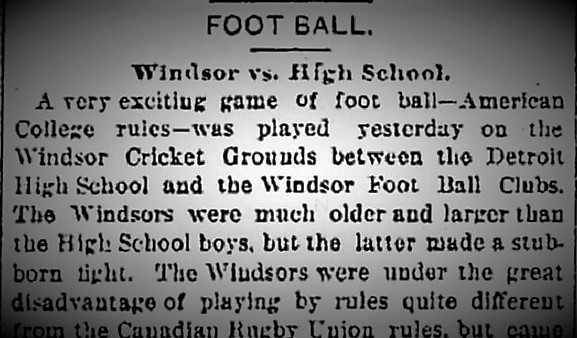
Football Kicks Off Again, 129 Years Later
By
Ron Pesch
MHSAA historian
August 25, 2017
Buried in the text on the fourth page of the Saturday, October 27, 1888, Detroit Free Press is a single, concise sentence bearing a minimum amount of detail.
“The Windsor foot ball team will play the Detroit High School team this afternoon at 3.”
To date, this is the earliest account of a Michigan high school playing the game of “foot ball.”
The following day’s paper provides only a few more details. The game was played on the Windsor Cricket Grounds. Despite the great disadvantage of playing under “American Football rules … quite different from the Canadian Rugby Union rules …” the “older and larger” Windsors won the contest, 12-6. Rosters for each squad were provided.
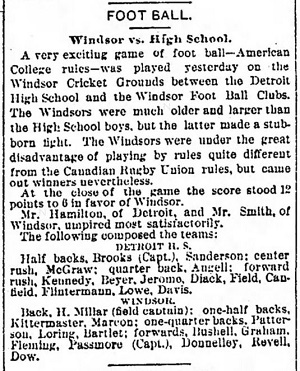 Under American rules of the time, a touchdown was worth four points, with a conversion kick following a touchdown worth two additional points. At the time, a field goal counted for five points and a safety was worth two. The teams, however, may have agreed to a different scoring system before the contest.
Under American rules of the time, a touchdown was worth four points, with a conversion kick following a touchdown worth two additional points. At the time, a field goal counted for five points and a safety was worth two. The teams, however, may have agreed to a different scoring system before the contest.
Was this the first football game for a Michigan high school? That’s unlikely, but it is certainly among the earliest published accounts involving a prep game in the state.
It’s a fair assumption that foot ball, or some version of the game, was being played in neighborhoods before that time, at least based on the following statement found in the Jackson Citizen Patriot, dated June 18, 1867. Only days before, Dorrance & Goodwin’s, a store on Main Street in Jackson, had placed advertisements in the newspaper’s classifieds noting the pending arrival of this new product.
“Foot Ball – The pastime was inaugurated on our streets yesterday. Three or four balls were kept in motion all day on Main street alone. It affords no little amusement to the little boys, and is certainly a healthy exercise for the larger ones. It’s all right as long as no windows are broken or horses scared. Both calamities were barely escaped scores of times during the day.”
Rutgers and Princeton are credited with playing the first college football game in 1869. A decade later, in 1879, the University of Michigan established a football team.
Detroit High School played a number of games in 1888, besides the Windsor match, including a contest with the Tappen School from the Corktown area of Detroit. Played at the Detroit Athletic Club grounds on the afternoon of Thursday November 15, a final score was not mentioned in the following day’s Free Press.
For those unfamiliar with the sport, an account of the University of Michigan versus Detroit Athletic Club contest that appeared in the November 18 Free Press served as a fine introduction to the game, and the determination behind securing “possession of a leather-covered foot ball.”
“It was very interesting to see one speedy young man, after a desperate struggle in which the spectators fully expected to see him lose an arm or a leg, get away from his captors and start like a deer, with eight or ten of the opposite side in full pursuit. He is overtaken and the leader of the pursuing party springs upon the back of the man with the inflated trophy, bearing him to the ground with a dull thud … It is also an inspiring sight to see a fleet-footed player seize the ball and run at full speed in the direction of the goal of his opponents. Then a wing-footed opponent cuts across to intercept him, makes a flying leap, grasps the fugitive around the neck or waist and both go to grass with a suddenness and velocity that transforms them into human wheels …
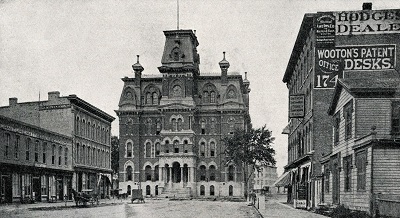 “While one unaccustomed to foot ball will naturally be startled by some of the acrobatic feats, still it is impossible to watch the game for any length of time without a tingling of the blood and holding of the breath. It is most intensely exciting, continuous in action and replete with fine points of play.
“While one unaccustomed to foot ball will naturally be startled by some of the acrobatic feats, still it is impossible to watch the game for any length of time without a tingling of the blood and holding of the breath. It is most intensely exciting, continuous in action and replete with fine points of play.
“It may be explained that the goals in a foot ball game are set at a distance of 330 feet from each other. The goal is made by placing two pieces of scantling twenty feet long upright in the ground, eighteen and one-half feet apart. Another piece runs midway horizontally between the uprights, and the ball must go over the horizontal piece and between the uprights to count a goal. There are eleven men on each side and the object is, of course, to get the ball through the goal of the other. The time of game is an hour and a half each side playing forty-five minutes from each goal, with an intermission of ten minutes between halves.”
A player who ran over an opponent’s goal line, “with the ball and touched it down” was then entitled to “bring the ball in front of the goal and attempt to kick it through”…
Among those playing for the Athletic Club squad that day was “little Hugh Brooks (captain) of the high school team.” Eligibility rules for players would evolve over time.
On Saturday, November 24, Detroit High School squared off for the first of two contests with Ann Arbor High School, this one at the Detroit Athletic Club grounds. Admission to the 2:45 p.m. contests was 25 cents. A crowd of around 300 watched “an exciting illustration of how Rugby foot ball is played. The exhibition by the Ann Arbor boys was considerably better than that of the Detroiters,” noted the Free Press, “the result of that being that Detroit’s banners have been kicked into the dust.”
Ann Arbor returned home with a 12-0 victory.
A second game with Ann Arbor was quickly scheduled.
In between, on Thursday, November 29, the Detroit High School squad played the Athletic Club before a crowd of about 200.
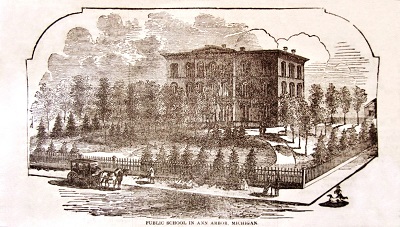 “While the Athletics won by 12 to 0, still their playing was very loose, probably the result of over confidence. The Athletics will have to rid themselves of this by Saturday or the Albions will make short work of them.”
“While the Athletics won by 12 to 0, still their playing was very loose, probably the result of over confidence. The Athletics will have to rid themselves of this by Saturday or the Albions will make short work of them.”
A large crowd gathered in the drizzling rain in Ann Arbor on Saturday, December 8, for what appears to be the final contest of the 1888 season for the high school teams of Detroit and Ann Arbor.
“It was a fine game. (Captain) Brooks, McGraw and Wisner, for Detroit, and Jewett, Diggert, Dupont, and Rathbone for Ann Arbor, made fine plays for their respective sides.” The result was an 8 to 2 win, and redemption, for the Detroit squad.
Today, 129 years later, “football” has seen wild expansion, numerous rule changes, and huge advancement in equipment worn when compared to those pioneer days of the sport. In 2017, more than 1 million individuals will suit up for high school teams across the United States. In Michigan alone, more than 36,000 participate in prep football.
And our state’s original programs live on. On Friday, Detroit Central opened its season with a win over Detroit Loyola. Ann Arbor High School, renamed Ann Arbor Pioneer in the late 1960s, fell in its Friday opener to Muskegon.
Welcome to another season of America’s favorite pastime.
 Ron Pesch has taken an active role in researching the history of MHSAA events since 1985 and began writing for MHSAA Finals programs in 1986, adding additional features and "flashbacks" in 1992. He inherited the title of MHSAA historian from the late Dick Kishpaugh following the 1993-94 school year, and resides in Muskegon. Contact him at [email protected] with ideas for historical articles.
Ron Pesch has taken an active role in researching the history of MHSAA events since 1985 and began writing for MHSAA Finals programs in 1986, adding additional features and "flashbacks" in 1992. He inherited the title of MHSAA historian from the late Dick Kishpaugh following the 1993-94 school year, and resides in Muskegon. Contact him at [email protected] with ideas for historical articles.
PHOTOS: (Top) The Detroit Free Press included brief coverage of the first "reported" game on Oct. 28, 1888. (Middle) When Michigan’s state government moved from Detroit to Lansing in 1847, the old Capitol building was re-opened as the Detroit’s first city high school in 1863. To better accommodate Detroit’s growing population, the old two-story structure was remodeled into a four-story building, unrecognizable to most. The school served the city well until January 1893, when it burned to the ground. (Below) Erected in 1856 at the cost of $27,000, Ann Arbor High School at State and Huron (now site of the North Quad of the University of Michigan) was destroyed by fire in 1904. (Photos courtesy of Ron Pesch.)
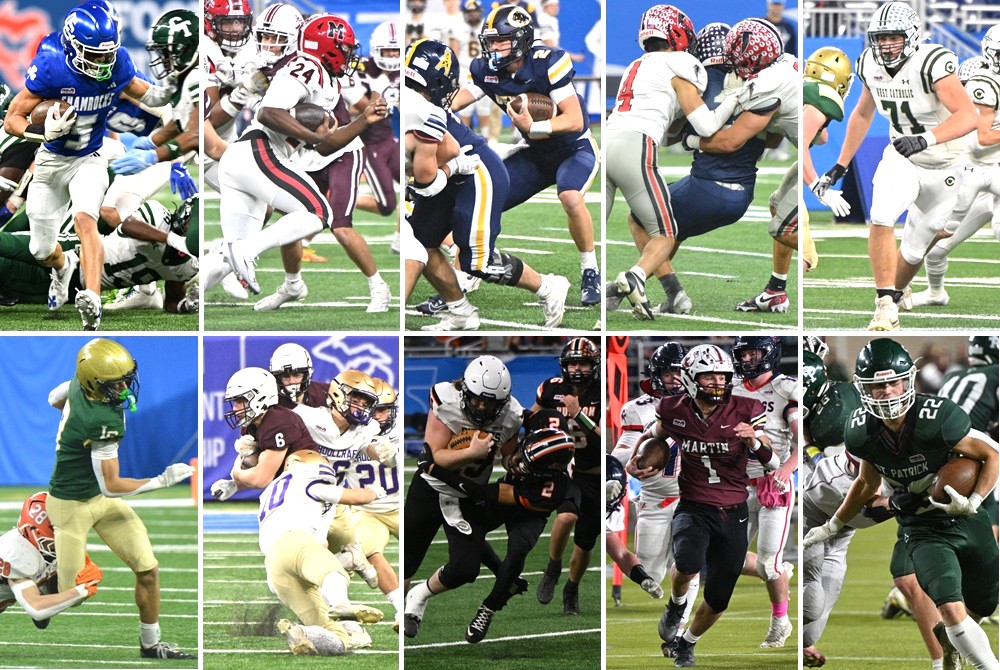
1st & Goal: 2025 Football Finals Review
By
Geoff Kimmerly
MHSAA.com senior editor
December 3, 2025
This season’s MHSAA Football Finals saw only two of 20 teams reach championship games for the first time – the lowest number of first-timers since the start of the 2020s – but several more play for Finals titles for the first time in a decade, or two, or even three or four.
 Dearborn Divine Child won its first championship since 1985, Portland St. Patrick its first since 1992, and Harbor Beach, Menominee and Detroit Catholic Central all claimed their first titles in more than a decade as this fall came to a close over the last two weekends.
Dearborn Divine Child won its first championship since 1985, Portland St. Patrick its first since 1992, and Harbor Beach, Menominee and Detroit Catholic Central all claimed their first titles in more than a decade as this fall came to a close over the last two weekends.
We also had repeat winners – Orchard Lake St. Mary’s, Jackson Lumen Christi and Martin – and although their runs ended in defeat, Blanchard Montabella and Dexter did advance to championship weekends for the first time.
MHSAA.com once again covered all 10 championship games, with quick recaps and links to those stories below followed by notations of performances entered into the MHSAA Finals record books and a report on some of the main storylines to emerge as those championships were being decided.
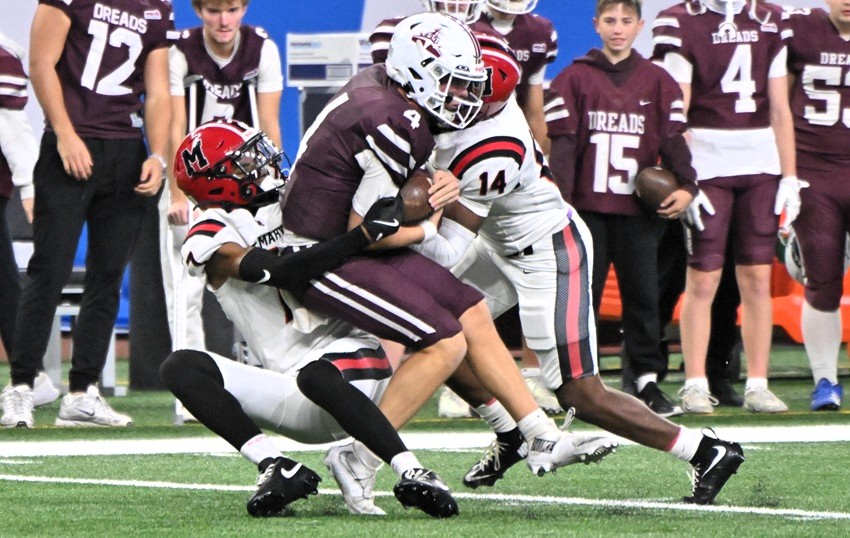
Finals in Review
11-Player Division 1: Detroit Catholic Central 42, Detroit Cass Tech 19 – Read
DCC claimed its first Finals championship since 2009 by emerging from this matchup of undefeated teams and avenging a 2024 Semifinal loss to eventual champion Cass Tech. While Shamrocks senior Samson Gash has received some of the highest statewide praise for his offensive talents this season, junior brother Gideon Gash starred this time with three touchdown catches all 37 yards or longer.
11-Player Division 2: Orchard Lake St. Mary’s 51, Dexter 14 – Read
Orchard Lake St. Mary’s repeated as Division 2 champion following quarterback Jabin Gonzales (304 yards/4 TDs passing, 102 yards rushing) but also thanks to a stellar defensive effort against the Dreadnaughts’ record-setting offensive attack. The Eaglets held Dexter to just 266 total yards, and only 69 during the second half after taking a 24-14 lead into the break.
11-Player Division 3: DeWitt 54, Mount Pleasant 20 – Read
This was another matchup of undefeated contenders, and DeWitt again lit up the scoreboard in winning its second championship. The Panthers set a team Finals record for most rushing yards (575) with senior Traverse Moore claiming the individual Finals rushing record with 397 – 83 more than the previous all-time best.
11-Player Division 4: Dearborn Divine Child 23, Hudsonville Unity Christian 22 – Read
Divine Child’s first Finals championship since 1985 was a product of steady play on both sides of the ball. Offensively, Marcello Vitti ran 19 times for 120 yards and a score and Drew Sheridan completed 19 passes for 241 yards and two touchdowns. Defensively, Divine Child stopped a two-point conversion try midway through the fourth quarter to keep a one-point lead, then held Unity to two yards on its final possession.
11-Player Division 5: Grand Rapids West Catholic 42, Pontiac Notre Dame Prep – Read
West Catholic jumped out to a 28-0 lead and didn’t allow reigning champion Notre Dame Prep to get on the scoreboard until the final minute of the first half. The 1-2 punch of running back Collin Abram and quarterback Grady Augustyn accounted for a combined 347 yards for the Falcons, and the Fighting Irish also lost all-state quarterback Sam Stowe for the majority of the second half with an injury.
11-Player Division 6: Jackson Lumen Christi 28, Kingsley 15 – Read
The Titans claimed a fourth-straight Finals championship and repeat in Division 6 by scoring the game’s only second-half points – 14 to go ahead and stay there during the fourth quarter. Lumen Christi’s Sean Walicki starred on both sides of the ball, running for 142 yards and two touchdowns and making 17 tackles.
11-Player Division 7: Menominee 34, Schoolcraft 6 – Read
Two years after finishing Division 7 runner-up and only four points shy of Lumen Christi in that title decider, Menominee returned to Ford Field and won its first championship since 2007. Clayton Miller ran for 112 yards and three touchdowns for the Maroons, who finished a perfect 14-0. Schoolcraft’s only points came with 6:09 to play.
11-Player Division 8: Harbor Beach 31, Hudson 20 – Read
The 11-Player Finals opened with a matchup of undefeated contenders. Harbor Beach withstood Hudson’s powerful running attack and followed quarterback Caden Bucholtz (146 yards/1 TD rushing, 82 yards/2 TDs passing) to its first Finals title since 2012. The Pirates took a 21-0 lead into the final four minutes of the first half and got a scoring run, touchdown reception and 20-yard field goal from Skiler Kruse.
8-Player Division 1: Martin 52, Blanchard Montabella 8 - Read
Hudson claimed its third Division 1 title in four seasons with a dominating performance, as Montabella scored the game’s first points but were held off the board the rest of the way. Quarterback Haylen Buell ran for 179 yards and three touchdowns on only nine carries, and completed all seven of his passes – including one for another score – for the undefeated Clippers.
8-Player Division 2: Portland St. Patrick 53, Felch North Dickinson 0 – Read
The Shamrocks seemed to set the tone on the opening kickoff – returning it to North Dickinson’s 3-yard line – on the way to winning their first 8-player championship and first in either football format since 1992. St. Patrick led 20-0 after just seven minutes and 33-0 at halftime, with seven players reaching the end zone at least once by the end of the contest.
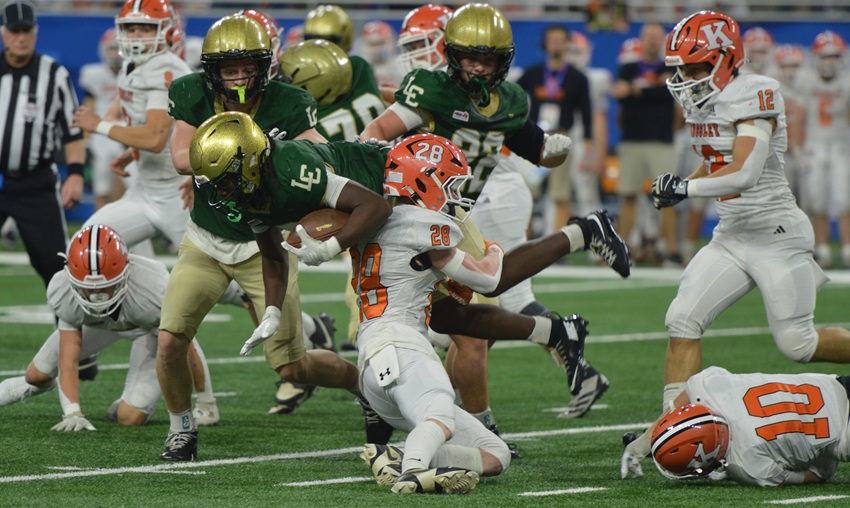
Record Report
Detroit Catholic Central and Jackson Lumen Christi moved into a first-place tie with Farmington Hills Harrison for 11-Player Finals appearances as all three have played in 18. (Harrison closed in June 2019).
DeWitt senior Traverse Moore earned seven 11-Player Finals record book listings, his most notable for an all-time best 397 yards rushing – which broke Kadale Williams of Lumen Christi’s record of 314 set just last season. Moore also set records with three touchdown runs during the first quarter, and his 461 total yards (including 64 passing) are the second-most in Finals history. He made four more lists as well, including for 24 points scored.
Mount Pleasant quarterback Xavier Creguer also set a record during the Division 3 game, his 91-yard scoring run the longest rush in 11-player championship game history.
Three kickers made the 11-player single-game extra points list with six apiece – Orchard Lake St. Mary’s Beckett Keifer in Division 2, DeWitt’s Vincent Rose in Division 3 and Grand Rapids West Catholic’s Landon Smith in Division 5
A trio of quarterbacks also made 11-player record lists. Orchard Lake St. Mary’s Jabin Gonzales did so with 304 yards passing, his four touchdown tosses, and 406 total yards (including 102 rushing); the total yards rank eighth all-time. Detroit Cass Tech’s Donald Tabron II made passing lists with 25 completions, 37 attempts and 285 yards, and Dearborn Divine Child quarterback Drew Sheridan also made the completions list with 19. Tabron’s attempts rank eighth, and his completions tied for fourth on that list.
On the receiving end of some fine quarterback play, Cass Tech’s Corey Sadler Jr. made the 11-player single-game receptions list with 11, tying for third-most catches, while Grand Rapids West Catholic’s Thomas Puksta made the single-game receiving yardage list with 161 and Detroit Catholic Central’s Gideon Gash tied for the second-most touchdown receptions with three.
Dexter’s Cole Novara rewrote the season receiving records this fall, and added an 11-player championship game listing with a 96-yard kickoff return touchdown. St. Mary’s Daniel Taylor Jr. also made a return list, bringing back a fumble 59 yards for a score.
DeWitt with 54 points made the 11-player team single-game scoring list, but that was just the start. The Panthers’ 575 rushing yards and 639 total yards were records, their seven rushing touchdowns tied another one, their 24 first downs made a record list and their combined 959 total yards with Mount Pleasant made the total offense list for both teams in one game.
Orchard Lake St. Mary’s also made the 11-player scoring list with 51 points, and earned another entry with 314 passing yards. Dexter made the single-game completions list in that game with 24, and Detroit Cass Tech made that same list with 25 completions. Hudsonville Unity Christian made the single-game rushing carries list with 66.
Grand Rapids West Catholic tied the Finals record with two other teams by returning two interceptions for touchdowns.
Hudson made the list of teams that did not punt in a Final, and also joined Harbor Beach – which punted once – on the list for fewest punts by both teams combined in one game.
Martin quarterback Haylen Buell made the 8-player total yardage list with 313 in the Division 1 game, leading a Clippers attack that also made the single-quarter points list with 30, single-Final rushing list with 364 yards and rushing touchdown list with six.
Portland St. Patrick quarterback Jerryd Scheurer made the list for fastest touchdowns to begin an 8-Player Final, scoring on a run just 20 seconds into his team’s Division 2 win against Felch North Dickinson. St. Patrick also made the single-game touchdowns list with seven.
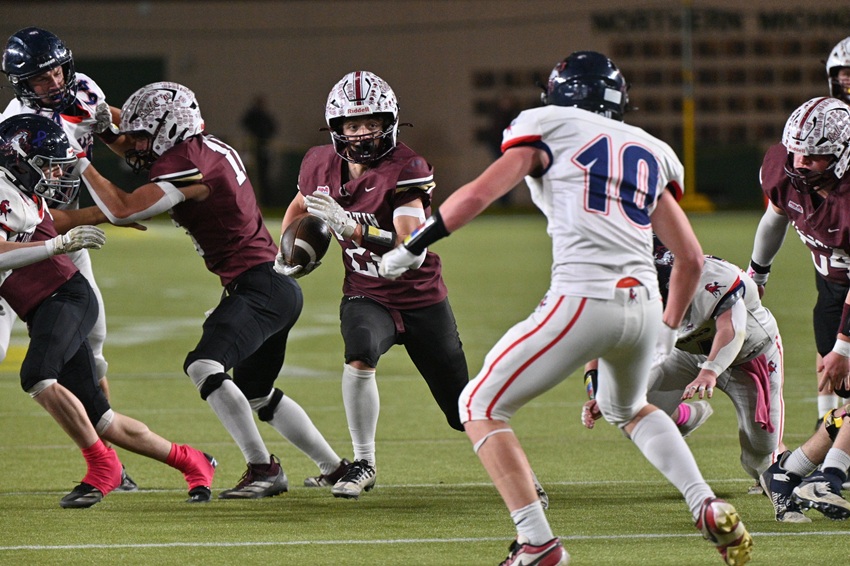
Stories Behind the Scores
Single Wing, Several Records: We detailed above most of how DeWitt ran its way into the Finals record book, but the Panthers’ strategy this season deserves more credit for its brilliance. Recognizing his team’s strength on the offensive line and depth of dynamic ball carriers, DeWitt coach Rob Zimmerman leaned heavily on single wing concepts that saw direct snaps to Traverse Moore – technically his quarterback – who then ran behind multiple blockers or worked through counters and other slights of hand that opened up multiple running lanes on just about every play. The Panthers have added several record book entries over the last 25 years thanks to a high-scoring spread passing attack, but they followed last season’s 702 points (ranking eighth all-time before this fall) with 727 this season that will ran fifth on the single-season scoring list. Moore finished with 2,512 yards and 33 touchdowns rushing, and it will be interesting to see if other programs follow suit by incorporating single-wing looks.
Memorable Menominee: The Maroons were once known as one of the last teams to run the single wing, and although they’ve added different looks and more balance under fourth-year coach Chad Brandt, that tough-running, physical culture lives on – and played a big part in Menominee’s perfect season and first Finals championship since 2007. The Maroons just missed winning the Division 7 title in 2023, losing to Jackson Lumen Christi 34-30, but came through this time to claim the Upper Peninsula’s first 11-player championship since 2015. This season, only 16 UP teams played 11-player, while 19 played 8-player.
Watch List: A total of 44,733 fans attended the 11 or 8-Player Finals this season, the highest combined total for the three days since 2019 and despite a snowstorm that blanketed much of the Lower Peninsula over the 11-player weekend. A notable crowd of fans also watched online; although this was the first year the 11-Player Finals were streamed only, on the NFHS Network, we know that the Division 1 championship game drew the fourth-most viewers all-time of any event from any state broadcast on the Network, and that they watched the game for the most minutes ever for a Network broadcast.
MHSAA.com's weekly “1st & Goal” previews and reviews are powered by MI Student Aid, a division within the Department of Lifelong Education, Advancement, and Potential (MiLEAP). MI Student Aid encourages students to pursue postsecondary education by providing access to student financial resources and information. MI Student Aid administers the state’s scholarship and grant programs that help make college Accessible, Affordable and Attainable for you. Click to connect with MI Student Aid and find more information on Facebook and Twitter @mistudentaid.
PHOTOS (Top) This collage shows action photos from all 10 MHSAA Finals played this season. (2) Orchard Lake St. Mary’s Kareem Pruit (7) brings down Dexter quarterback Cooper Arnedt in 11-player Division 2. (3) Kingsley’s Nolan Hodges (28) wraps up Lumen Christi’s Ayden Gatewood in Division 6. (4) Martin’s Seth Toris (24) charges through a hole with Montabella’s Noah Carlson lining up to attempt a tackle in 8-player Division 1.

